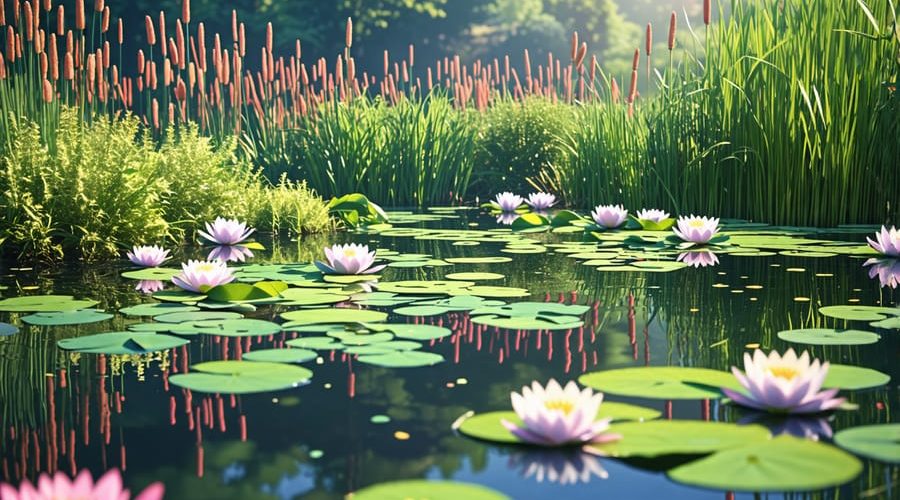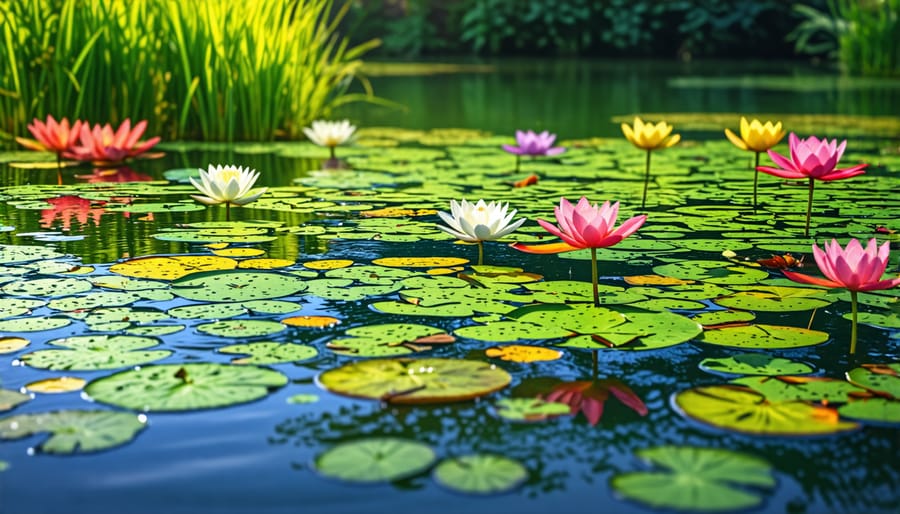
Bring Your Pond to Life: Beautiful Plants That Thrive in Water
Choose hardy plants like water lilies or lotus; their vibrant blooms thrive in ponds with minimal care. Anchor root floaters like hyacinth or duckweed—they beautify surfaces and filter water naturally. Propagate pothos by snipping stems and placing them in clear containers to watch roots grow, adding green vibes indoors and outdoors. Regularly refresh water to prevent stagnation and boost plant health. For more ideas for your backyard pond, explore methods to incorporate these plants seamlessly into your water garden.
Why Grow Plants in Water?
Aesthetic Appeal
Imagine a serene pond glistening under the sun, adorned with vibrant water lilies floating gracefully on the surface. Water plants like these can transform any pond or water garden into a tranquil masterpiece. Not only do they create a lush, colorful landscape that pleases the eye, but they also bring life and balance to your aquatic setting. From the elegant sway of reeds to the colorful splash of irises, each plant adds its own unique charm. With foliage providing natural shade and flowers offering bursts of color, water plants are the perfect way to enhance your outdoor oasis with simple elegance.

Ecological Benefits
Plants play a vital role in maintaining a healthy pond ecosystem. They act as natural filters, absorbing excess nutrients and reducing algae growth, which keeps the water clear and balanced. By releasing oxygen during photosynthesis, aquatic plants help sustain the pond’s underwater life, creating a thriving environment for fish and beneficial micro-organisms. Furthermore, these plants offer shelter and breeding grounds for various aquatic creatures, promoting biodiversity. Beyond their ecological benefits, aquatic plants enhance the aesthetic appeal of ponds with their lush greenery and vibrant flowers. Embracing water plants not only beautifies your pond but also contributes to a sustainable aquatic habitat.
Best Plants for Water Growth
Floating Plants
Floating plants, like the charming water lettuce and vibrant duckweed, can transform your water garden into a lush oasis. These plants happily drift on the water’s surface, creating a natural tapestry that’s both beautiful and functional. Not only do they add a soothing aesthetic, but they also offer practical benefits, like providing shade to control algae growth and offering a habitat for aquatic life. Water lettuce, with its rosette of velvety leaves, is a favorite among pond enthusiasts for its ability to thrive with minimal maintenance. Duckweed, on the other hand, is perfect for those looking for rapid growth to cover surfaces quickly. To cultivate these beauties, simply introduce them to your pond, and they’ll do the rest—spreading out and flourishing with sunlight and nutrients from the water. Remember, a little goes a long way, so start with a modest amount and watch them multiply, turning your pond into a serene haven of floating greenery.
Submerged Plants
Submerged plants, like hornwort and anacharis, are fantastic additions to any water garden or pond. These plants grow entirely beneath the water’s surface, providing essential oxygen and helping to maintain clear, clean water. DIY enthusiasts and pond lovers will appreciate that submerged plants also offer habitat for fish and other aquatic creatures, enhancing the natural ecosystem.
Hornwort is a beginner-friendly choice due to its adaptability and robust growth. It doesn’t root in the soil, which makes it easy to add anywhere in the pond, where it will float freely and anchor itself naturally over time. Anacharis, on the other hand, can be planted directly into the substrate, where it will quickly establish and spread. It’s an excellent filter for toxins and excess nutrients, making it particularly useful for maintaining water quality.
Both hornwort and anacharis are low-maintenance options, requiring minimal attention once established. Whether you’re creating a new pond or sprucing up an existing one, these submerged varieties offer both beauty and functionality.
Marginal Plants
Marginal plants are the unsung heroes of any water garden, thriving right at the edge of ponds and providing both aesthetic appeal and ecological benefits. Picture the graceful sway of cattails; these plants not only add vertical interest to your water garden but also provide habitat for various aquatic creatures. Cattails are incredibly hardy, capable of growing in a range of water conditions, which makes them perfect for both beginner and seasoned water gardeners.
Equally stunning are irises, with their vibrant blooms adding a pop of color to the water’s edge. These hardy perennials are not just pretty faces; they’re remarkably resilient, able to withstand fluctuating water levels. Planting them is as simple as nestling their rhizomes in muddy banks or shallow water, ensuring their crowns are just above the surface. They’ll reward you with elegant blossoms that are sure to impress any pond visitor.
What’s fantastic about marginal plants is that they’re low-maintenance once established. They naturally filter the water, reducing algae and keeping your pond ecosystem vibrant and healthy. They can even help prevent erosion by stabilizing the pond edges with their extensive root systems. So, if you’re looking to create a serene, flourishing water haven in your backyard, don’t overlook the power of marginal plants!
How to Start Growing Plants in Water
Preparing Your Water Garden
Creating a thriving water garden starts with proper preparation. Begin by selecting a sunny spot, as most plants require ample sunlight to flourish. Ensure your pond or container is at least 18 inches deep for optimal plant growth. Fill it with clean, de-chlorinated water and consider using natural pond aeration to maintain oxygen levels. Add a layer of aquatic soil, specifically designed for water plants, to provide essential nutrients. Arrange plants thoughtfully, placing taller species at the back and shorter ones at the front, creating a harmonious landscape. Enjoy your personalized aquatic paradise!

Planting Techniques
Growing plants in water can be a rewarding and fascinating experience, particularly if you enjoy water gardening. To start, choose plants that thrive in aquatic environments such as pothos, lucky bamboo, or herbs like mint. Begin by selecting a healthy cutting from your chosen plant. Look for a stem that has a few leaf nodes as these are key sites for root development. Remove any leaves near the base to prevent them from rotting in water.
Next, fill a clear container with clean water—tap water is often fine, but allowing it to sit for 24 hours will let any chlorine dissipate. Place the cutting in the water so that the nodes are submerged. Ensure the plant receives indirect sunlight, as too much direct sun can encourage algae growth. Change the water weekly to keep it oxygenated and free of bacterial build-up.
If you’re introducing plants to a pond, a weighted pot can help keep the roots submerged while preventing the whole plant from floating away. You’ll soon see new roots sprouting, marking the beginning of your water garden’s life!
Maintaining Healthy Water Plants
Nutrient Management
Growing plants in water is a delightful affair, but they still need nutrients to thrive. To ensure your water garden is lush and vibrant, you can add water-soluble fertilizers specifically designed for aquatic plants. These fertilizers contain essential elements like nitrogen, phosphorus, and potassium, which help boost growth and maintain health. Be sure to follow package instructions to avoid over-fertilizing, as this can lead to algae growth. With the right nutrient balance, your water garden will become a thriving, beautiful oasis.
Pest and Disease Control
To keep your water plants healthy, regularly inspect them for common pests like aphids or snails. A gentle spray of water can wash away small infestations. For diseases such as root rot, ensure your plants are not overcrowded and have good water circulation. Adding a few mosquito fish can naturally control mosquito larvae and keep the ecosystem balanced. Keep a watchful eye, as early detection and prompt action are key to maintaining vibrant water gardens.
Conclusion
Embracing the beauty of a water garden can transform your outdoor space into a tranquil paradise. By selecting the right plants and following clear planting methods, you can create a thriving aquatic haven. Dive in and start your own water garden journey today, enjoying the serenity and satisfaction it brings to your home.
